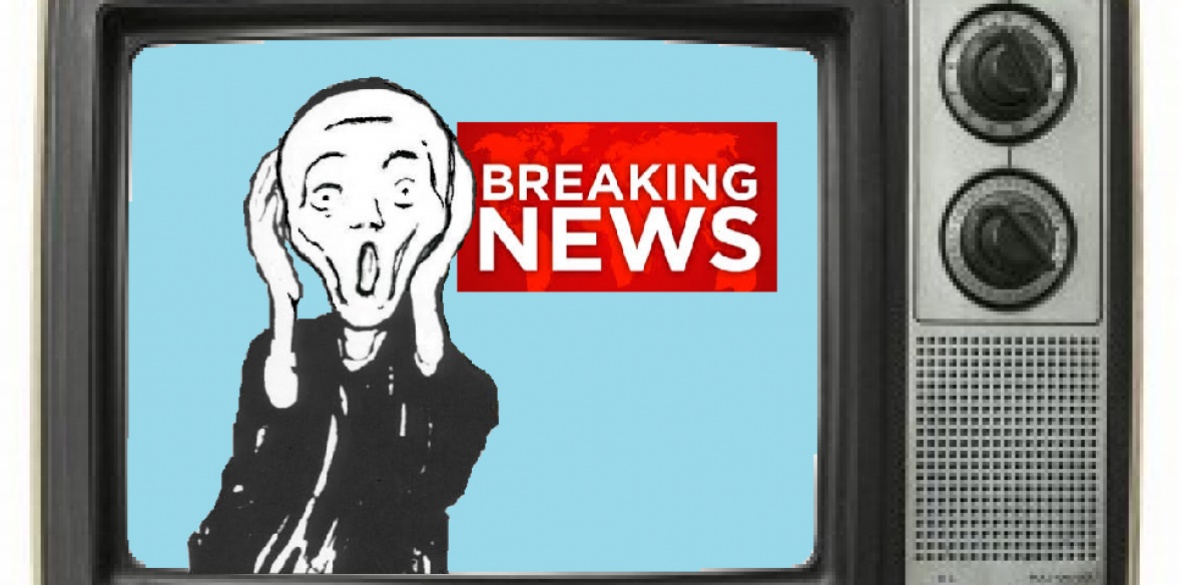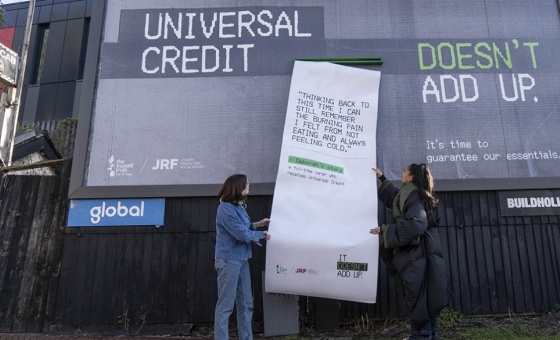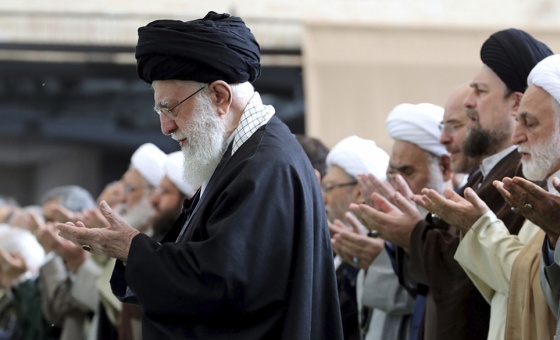This is the last article you can read this month
You can read more article this month
You can read more articles this month
Sorry your limit is up for this month
Reset on:
Please help support the Morning Star by subscribing here
A SPECTRE is haunting Britain’s right-wing newspapers — the spectre of desperation.
Devoid of credibility and condemned to watch the slow collapse of their neoliberal weltanschauung (world outlook), it seems all they have left to exploit is the power of fear.
“Commie spy,” “loony lefty,” “traitor,” “Britain-hating ideologue,” “terrorist sympathiser” and “threat to our national security.” These are just a few of the desperately absurd scare-terms the right-wing press has tried to pin on Jeremy Corbyn over the past few years.
Of course, none of it should be a surprise. The incessant attempts to associate him with “communists” and “terrorists” and various kinds of bogeymen are in fact standard protocol for an Establishment feeling deeply threatened.
I was reminded of this recently while rereading the work of the late Alex Carey. In his study Taking the Risk out of Democracy: Corporate Propaganda Versus Freedom and Liberty, Carey lucidly documented the rise of corporate propaganda in the US during the 20th century.
He showed how the extension of the popular franchise — that is, the spread of democracy — and the growth of trade union movements at the turn of the century led to a shift of power into the hands of public opinion and organised labour.
This threatened existing power and privilege, which, as he put it, responded by co-ordinating sophisticated propaganda campaigns to suppress “democratic aspirations and the interests of larger public purposes” and protect their own socio-economic interests.
The campaigns were devastatingly successful. Labour movements were quelled and democracy and civil liberties weakened. The period became known as the first red scare.
One of the means by which this scare was promoted was through the deliberate creation and preservation of symbols designed to exacerbate national hopes and fears.
Evangelical religious beliefs, for example, which had always been deeply ingrained in US society, were invoked, with dichotomies between God/Devil and good/evil used to frame secular political and economic issues.
This manifested itself most notably in efforts to depict communism and socialism as evil and capitalism and free-enterprise as good.
Scare was promoted through the deliberate creation of symbols designed to exacerbate national
hopes and fears
Business interests went to great lengths to symbolically identify the latter with “social harmony, freedom, democracy, the family, the church and patriotism” and to associate trade unions, welfare and government regulation of business with all things evil and menacing.
The emotional and psychological power of these symbols, Carey argues, grew to become a highly effective means of social control in the 20th century, invoked again, most notably, during the second red scare of the late 1940s and ’50s — also known as the McCarthy era).
Edward S Herman and Noam Chomsky, in their seminal work Manufacturing Consent: The Political Economy of the Mass Media, would later refer to this method of social control as “anti-communism.”
They argued that Western media’s consistent publicising of the conflicts and crimes of communist states ahead of those of non-communist states helped elevate opposition to communism to a “first principle of Western ideology and politics.”
Labelling people communists, they wrote, “helps mobilise the populace against an enemy and because the concept is fuzzy it can be used against anybody advocating policies that threaten property interests or support accommodation with communist states and radicalism. It therefore helps fragment the left and labour movements and serves as a political-control mechanism.”
Of course, this is exactly what has been happening with Corbyn in recent years. “Comrade Corbyn,” “Marxist,” “Trotskyite,” “Red Jez,” “Loony Lefty” and, most recently, “Commie Spy” are just a few of the labels deployed to evoke the deeply entrenched ideology of anti-communism.
Just as in the US, there is a long tradition of this in Britain. Scholars such as Andrew Defty, for example, have shown how consecutive British governments formed a “close and continuous liaison” with the US during the cold war to disseminate anti-communist propaganda both at home and abroad — see his work Britain, America, and Anti-Communist Propaganda, 1945-53.
And in their book Culture Wars: The Media and the British Left, media scholars James Curran, Ivor Gaber and Julian Petley identify a lineage of anti-communist demonisation within the British press, which has regularly tarred political parties and individuals with the so-called “Red brush.”
This was particularly common in the Margaret Thatcher era, during which accusations of “Marxist,” “Socialist,” “Trotskyite,” and “loony lefty” were perpetually levelled at anyone showing the mildest enthusiasm for trade unions, welfare and regulation of business.
Of course, the accusations are nearly always baseless and designed to smear by association. Note the absurdity, for example, when Ed Miliband was labelled “Red Ed” by the British press, despite advocating a public sector pay freeze and proposing to cut child benefits.
Or when Barack Obama was labelled a “socialist” by Republicans, despite having bragged about achieving “the lowest level of domestic [public] spending” since the 1950s.
I’ve written previously of the anti-communist ideology in BBC Newsnight’s reporting of Syriza in 2015. Despite their advocacy of mild Keynesian economic policies, they were overwhelmingly framed as “Marxists,” “Communists” and “Trotskyites” who were disrupting European harmony.
But these days it’s not just anti-communism that is invoked to demonise inconvenient people and groups.
As Herman and Chomsky have acknowledged, in the post-Soviet era there’s been a clear shift to a more general use of fear and “othering,” which nonetheless still maintains the good/evil dichotomy.
As Chomsky explains, “You need something to frighten people with, to prevent them from paying attention to what’s really happening to them. You have to somehow engender fear and hatred, to channel the kind of fear and rage — or even just discontent — that’s being aroused by social and economic conditions.”
One of the most powerful additions to anti-communism, Herman and Chomsky write, has been the “war on terror” or “anti-terrorism.”
In the case of Corbyn, this has manifested itself in persistent efforts to associate him with the IRA, Hamas, Hezbollah, Iran and “terror” more generally.
In a 2016 study entitled Journalistic Representations of Jeremy Corbyn in the British Press: from “watchdog” to “attack dog,” media scholars at LSE found that “the British press has repeatedly associated Corbyn with terrorism and positioned him as a friend of the enemies of the UK.”
Recall also how in 2015 the Conservative Party declared him “a threat to our national security, our economic security and your family’s security’ and how David Cameron publicly accused him of having a ‘security-threatening, terrorist-sympathising, Britain-hating ideology.”
More recently, on the eve of last year’s election, the Daily Mail ran a front-page headline calling Corbyn and his colleagues “APOLOGISTS FOR TERROR,” while the Sun ran a headline that read “JEZZA’S JIHADI COMRADES.” Only a month ago we saw “CORBYN THE COLLABORATOR” and “CORBYN THE COMMIE SPY” plastered across the same front pages, respectively.
Of course, in knowing a little history it’s clear to see what’s going on here.
Just like the democratic movements of the early 20th century, Corbyn’s politics and popularity are deeply threatening to our modern corporate-media Establishment, who are desperately trying to promote fear and hatred of him through their own propaganda campaigns.
The only problem is, however, that their propaganda doesn’t seem to be working so well.
Not only has the era of social media made it possible to debunk the increasingly absurd claims they make but the Internet has broken their grip on the control of information distribution more generally.
Unsurprisingly, people are seeking and appreciating alternative information sources, as public trust in the media and politicians is now at an all time low.
But this doesn’t mean that there isn’t cause for concern. It was only a month ago, after all, that a British nationalist told a court how he’d planned to kill Corbyn because he thought he was a “traitor.”
When questioned he said: “Oh yeah, it would be one less terrorist [on] our streets.” And it was only a year ago that the far-right killer of Labour MP Jo Cox stood in court and declared “death to traitors, freedom for Britain.”
Indeed, as the British press continues its hate-fuelled fear-mongering propaganda campaign to delegitimise Corbyn, which it will almost certainly ramp up when he is in office, we would do well to know a little history on this matter.
In fact, when just over 80 per cent of our newspapers are owned by five right-wing billionaires who have every intention of controlling what we think, a little understanding of history can go a very long way indeed.
Follow Callum Alexander Scott on Twitter @CallumAScott











